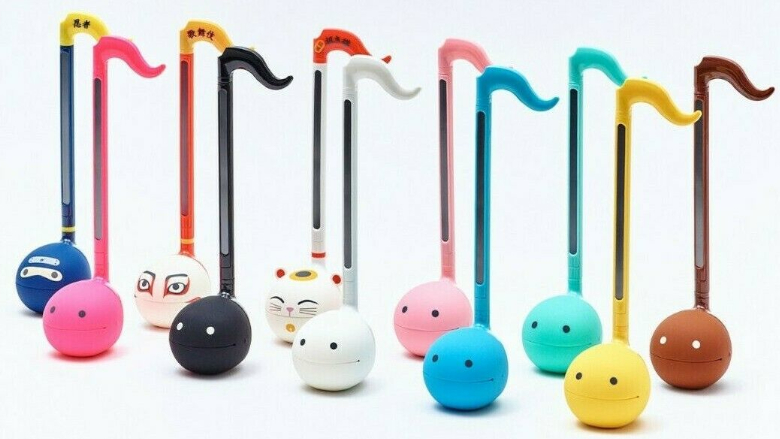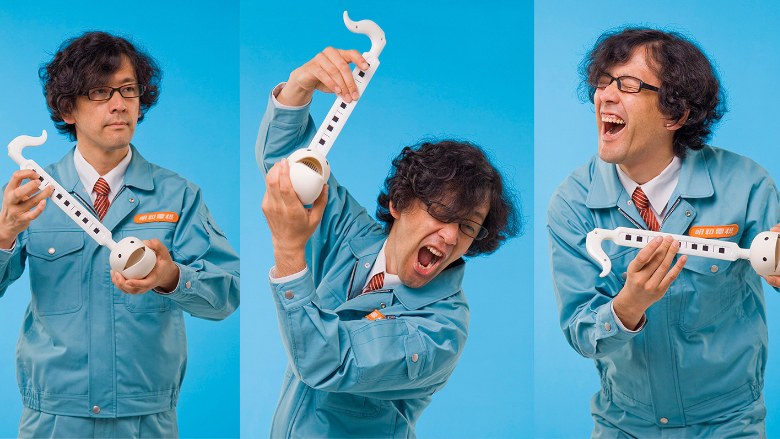
CUBE Works
The Otamatone is a one-of-a-kind instrument whose cute silicone face and charming analog synth sound have brought it ever-growing levels of popularity on the Internet. But there is much to unpack if you wish to understand not only how this strange Japanese toy works but why it has become such a potent social phenomenon. Without further ado, let’s dive into the wacky world of the Otamatone and find out what makes this such a fascinating instrument.
What Is an Otamatone?

CUBE Works
The Otamatone is a two-handed synthesizer instrument made in 2009 by Japanese toy company CUBE Works in collaboration with art unit Maywa Denki. Since then, its peculiar sound and unusual appearance have made it a popular choice for adventurous musicians like YouTuber TheRealSullyG. Check out their video below, which features 100 popular covers done on the Otamatone.
As you can see, the Otamatone has an impressive musical range despite being built and priced more like a toy than a professional stage instrument. It has a three-level pitch switch and a touch-sensitive ribbon controller that can slide between notes. Some versions even allow you to patch in other synth sounds and special effects. The end result makes it similar to a Stylophone or a keyboard but still entirely a class of its own.
Is the Otamatone Hard to Play?

CUBE Works
The core mechanics of the Otamatone may be simple to understand, but make no mistake that this is a legitimate instrument and therefore requires a fair amount of practice to master. You can find the basic concept on the back of the box: first, hold the Otamatone with the neck up, then press on its stem, then squeeze the mouth open to produce a sound. But it’s more complicated than that.
Unlike a guitar or a keyboard, the Otamatone’s notes aren’t marked by frets or keys. you have to register them by ear, which definitely takes some practice, especially if you haven’t played other instruments before. In the below video, YouTuber Rowan Skye offers some basic techniques on consistently finding notes and learning songs by ear.
What this video doesn’t cover is the full range of expression that the Otamatone is capable of. Rather than play with multiple fingers, advanced users can slide between notes by dragging one finger across the ribbon controller into the next note. You can also try wiggling your finger on a note to produce a vibrato-type effect.
So, yes, playing the Otamatone is a little trickier than it looks if you want to learn to cover songs like SullyG. That said, the Otamatone is made to be fun, so don’t feel like you need to dive into music theory lessons just to play with this synthesizer. You can totally still just pick it up and play and be delighted by the variety of wacky sounds you can produce.
Which Otamatone Should You Buy?

CUBE Works
Since its debut in 2009, the Otamatone has had a number of different versions released, which means prospective Otamatone players might have more options than they were expecting. Below we will go over the different versions and what sets them apart for the rest.
The Original Otamatone is the standard model of this synthesizer. It is approximately 10.6 inches tall and comes in a variety of colors including black, white, yellow, blue, and pink, and two transparent “skeleton” colors. It has two volume settings and three different octaves. It runs on three AAA batteries. It is the best option for beginners who just want to experiment with this unique instrument.
The Otamatone Neo is an improved version of the Original made to celebrate the instrument’s 10th Anniversary. It has the same suite of features albeit with a slightly wider fingerboard and compatibility with the Otamatone Studio app. It is available in either black or white.
The 17.3-inch Otamatone Deluxe is a slightly larger remake of the Original with a longer neck and upgraded electronics. It has an analog volume knob and a 3.5mm line-out jack so you can run your signal into an amp or pair of headphones. It can be powered by three AAA batteries or an AC input. It is available in black or white and has the same three-level pitch switch as the Original.
The Otamatone Techno has the same 17.3-inch form factor and improved feature set of the Otamatone Deluxe but with the added ability to link to several smartphone apps for extra features (just like the Neo). These allow you to change the synth sounds that are stored in the instrument (and add effects), making it as versatile as a full-on synthesizer. Check out this demo and unboxing from YouTuber LOOTd for a better idea of how this works.
The Otamatone Melody, or Otamatone Mini, is a keychain-sized variant which has no note selection slide and thus plays only predetermined tunes. It is mostly a novelty but you can always use it to make sure no one sits next to you on the bus.
Additionally, there are also a few limited-edition versions of the Otamatone that are harder to come by. These include the Otamatone Wahha GoGo, which is a reskin of the original instrument made to look like another Maywa Denki invention; the Otamatone Digital, which has a small piano-style keyboard instead of a slide-based note selector; and the Otamatone Jumbo, an oversized version that costs $300,000. These special versions are mostly for collectors, though, as they don’t offer any features that you’d miss from getting the normal version.
The Otamatone app is one of the newest additions to the Otamatone family. It is a free app that emulates the sounds of the original instrument using either your phone’s touchscreen or built-in gyroscope to control the sound. It is a great way to scratch that Otamatone itch when you don’t have your proper instrument with you.
See Also
13 Best DAC Amp Combos & Stacks For Any Budget
11 Best MIDI Foot Controllers: Which is Right For You?
11 Best Reference Headphones for the Studio